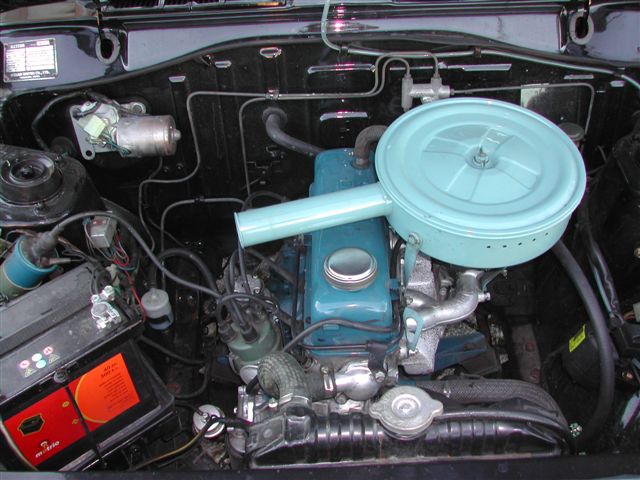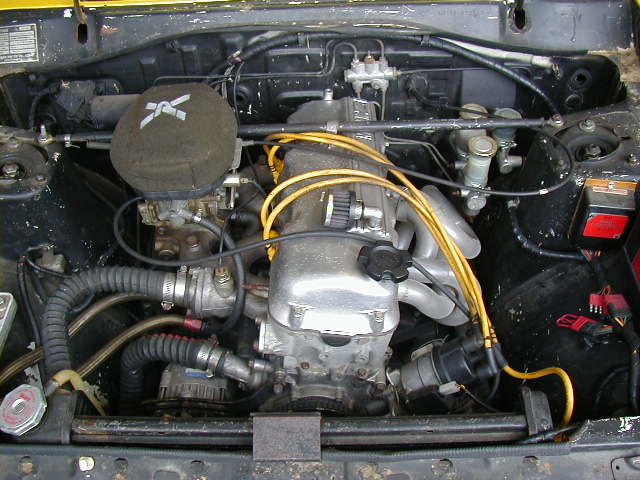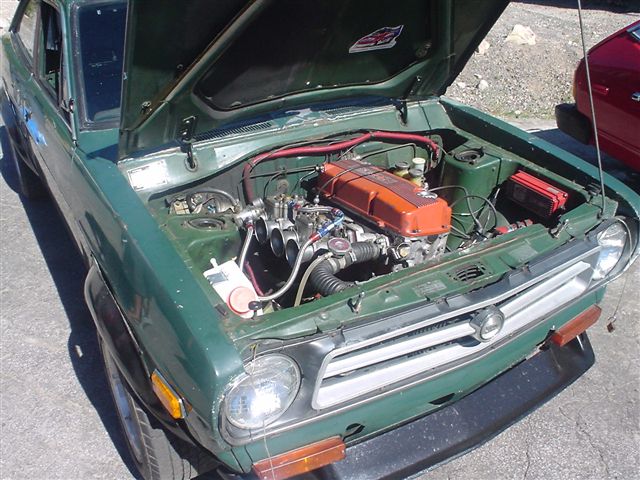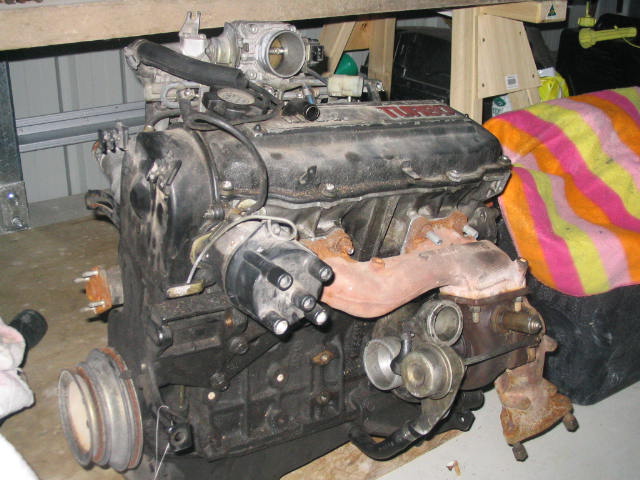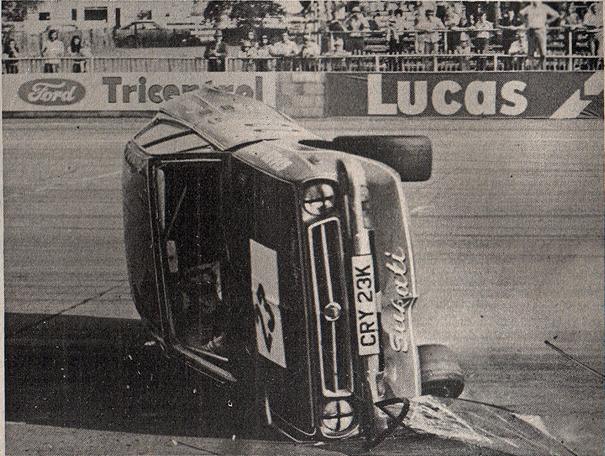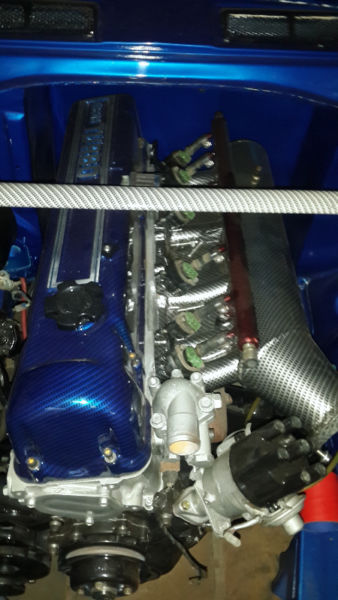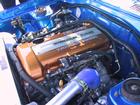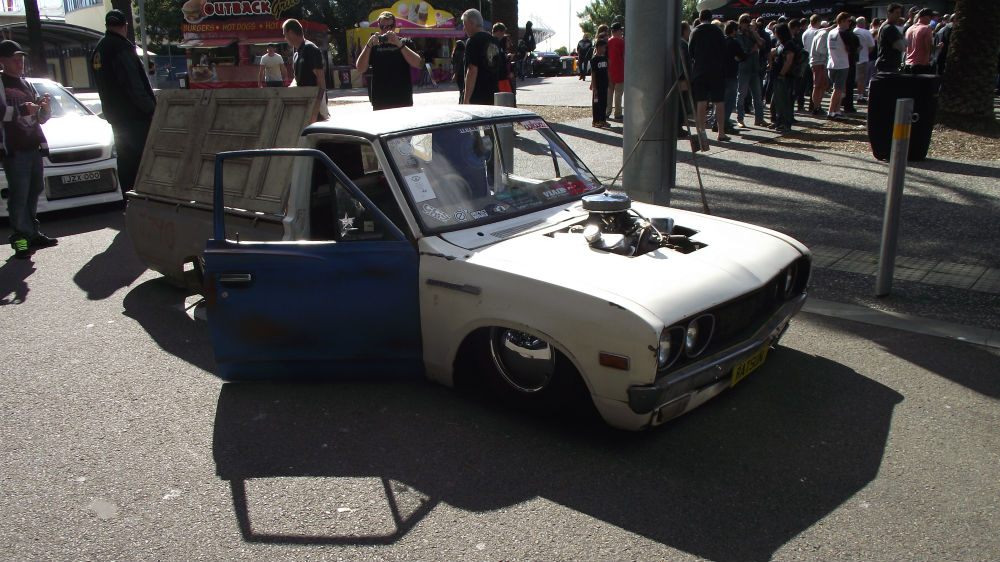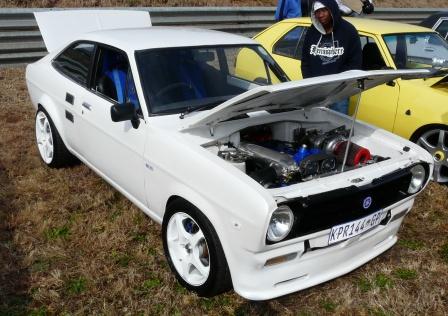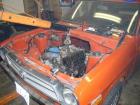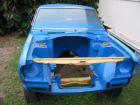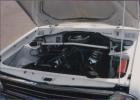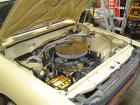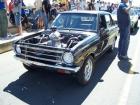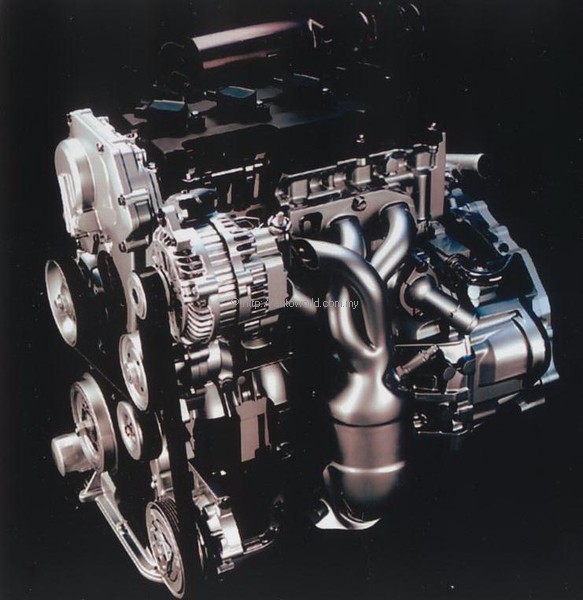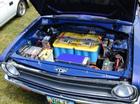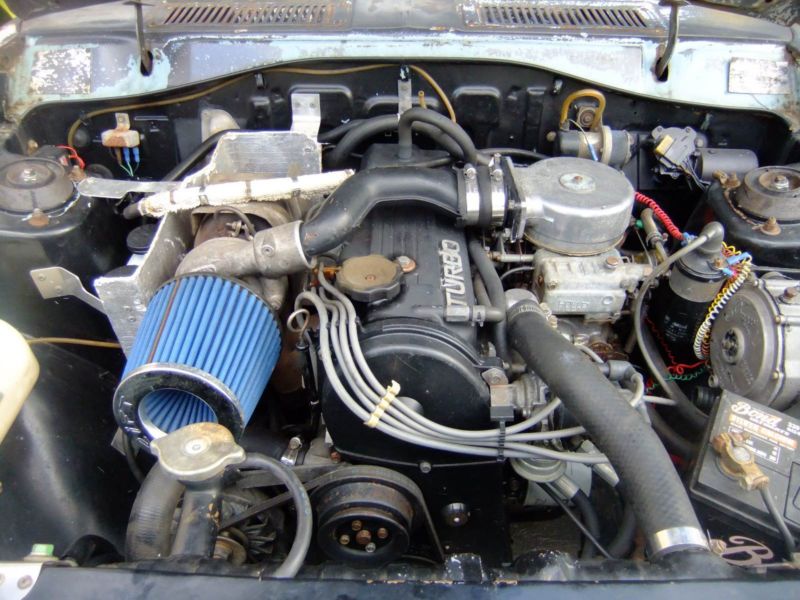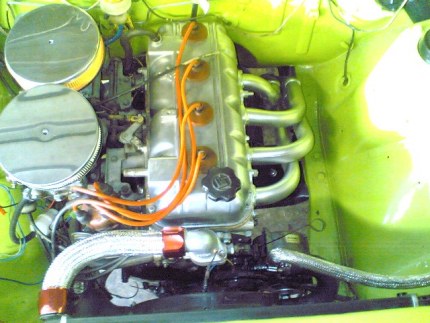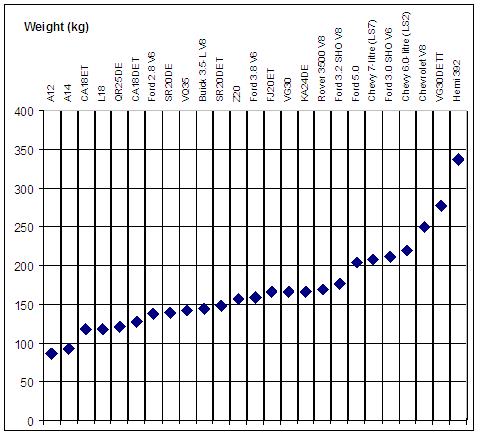| Revision as of 21:14, 17 August 2018 ddgonzal (Talk | contribs) (->RB Engine) <- Previous diff |
Revision as of 23:18, 17 August 2018 ddgonzal (Talk | contribs) (->Toyota Hemi) Next diff -> |
||
| Line 354: | Line 354: | ||
| === Toyota Hemi === | === Toyota Hemi === | ||
| - | See main article: [[Toyota T Engine Swap]] | + | {{Main|Toyota T Engine Swap}} |
| - | Toyota 2T | + | Toyota 2T in Datsun 1200 |
| - | <br>[http://datsun1200.com/modules/myalbum/photo.php?lid=19191 http://datsun1200.com/uploads/thumbs/19191.jpg] [http://datsun1200.com/modules/myalbum/photo.php?lid=18774 http://datsun1200.com/uploads/thumbs/18774.jpg] | + | <br>{{Album!|19191}} |
| === Toyota Twin-Cam === | === Toyota Twin-Cam === | ||
Revision as of 23:18, 17 August 2018
What's the Best Engine?
Engine stuff you need to know
Best engine -- the A12?
There is no "best" engine, unless popularity counts for anything. Millions of vehicles were produced with the A12 engine, making it the most successful. Plus, the 1971-1973 A12 simply fits into the B110 engine compartment by design of Nissan factory experts. And it is the most reliable and fuel-efficient engine in stock condition.
A special hi-power version of the A12 is the A12GX Engine. These came in Japan and South Africa Datsun 1200 GX models.
Should I build up my A12, or just get a bigger engine?
Building up your A12 can be quite fun and very educational. However, it will generally be more expensive than getting a larger engine. You could easily spend $2500-$4000 USD building up the A12. Also it will generally mean time that the car is not driveable, while an A14 engine swap can be done in a weekend.
On the other hand, if you find used parts, you could keep the cost down. Even adding a turbo is inexpensive if you do all the work yourself. Paying to have a shop do it usually costs around $2500-$4500 USD.
So what kind of performance increase can you expect? For $2500, you could drop from the stock 20-sec 1/4 time down to 17 seconds. That will make the car feel twice as fast. See discussion.
A12 stock: 69 HP A12 built: 80 HP $2500 A14 stock: 80 hp $900 good used engine A12 turbo: 127 hp $1200 EFI Turbo A12
A-series Nissan Engines
Similar engines in the Nissan A-type series are the 1974-and-up A12, A13, A14, A15 and A12A. All fit in the 1200 with only minor changes. These are by far the most popular swapping candidates, since they just about slide right in. Other pluses of the A-series are: light weight, smooth running, and availability of racing parts. These are all excellent engines, but the bigger displacement of the A14 and A15 means more power/torque than the A12, A13 or A12A.
A12 1970-1973 70mm stroke, 73mm bore early-mount type A12 1974-1994 70mm stroke, 73mm bore late-mount type A12A 1977-1982 70mm stroke, 75mm bore

A14 engine with factory A12 twin carbs

1974-up engines (including A12s) have the motor mount bosses in a different place compared to the 1971-1973 A12 engines. So the engine mounts are a bit different. This photos illustrates the difference:

A14/A15 Installation
What's Better? A14 or A15?
It depends on what you mean by 'better'. Better fuel economy? Better acceleration?
A14 advantages
- A14 often have better availability, meaning you can more often find one at an inexpensive price.
- Racing class rules may allow a 1400cc engine while disallowing larger engines. In this case the A14 will be preferred by racers. Even though the A15 would be faster, they are not allowed to use it in that particular class.
- A14 may achieve slightly better fuel economy
A15 advantages
- A15 has 7% more capacity than the A14, giving an automatic power increase in low and mid-range RPMs
- Since both use the same cylinder head, there is little top-end power advantage with either engine (both will put out the same top-end power, but the A15 has additional power at lower speeds)
- A14 and A15 stock bottom ends can both rev to 8,500 rpm so there's no advantage there. With modified short blocks, both can rev to 10,000 rpm
- A15 accelerates harder, when built the same (e.g. 80hp A15 vs 80hp A14) and geared the same
- A15 can give better fuel economy when paired with low-ratio diff final drive, although this will reduce the performance/acceleration down to A14 levels.
Remember: "There is no replacement for displacement"
But isn't the A15 stroke to long to rev high?
If you drive an A15-powered car, you will see the tachometer rev up. No worries.
A long stroke determines how fast wear occurs at a given RPM. But compared to an even longer stroke Chevrolet smallblock V8 running at 10,000 rpm, the A15 stroke looks small by comparison. A15s could rev even higher than 8,500 RPM, but just like the A14 would need special valve train modifications and for highest RPMs need a scavenging oil pump with dry sump to make it worthwhile.
Since A14s and A15s run the same cylinder head and valve train, maximum horsepower is for all practical purposes equal. All things being equal, with both the A14 and A15 using the same well-prepared and flowed cylinder head, they'll make the same top-end power.
Doesn't the A15 have an inferior cylinder head?
Not true. There is no A15-specific head, but all A15s use heads designed for the A14. Late A15s can come with a swirl-port head with reduced high-RPM power -- but that same head was used on A14s. Early A15s used either the early A14 oval-port head or the A14 round-port head.
My friend swapped in an A15 and it had less power than his A14 did
Yes, A15 comes in 80 hp verions and 67 hp versions. A14 came in 80 or 65 hp. The lo-power versions came with round port heads (or small-oval ports) and shorter-duration cams. So make sure you get the 80 hp version of the A15 (or swaps the cam & heads if you have a lo-power version).
Rod length-to-stroke ratio
A long rod-length-to-stroke ratio is more efficient. To get this, you need longer rods to match a longer stroke. However, A14 and A15 use the same length rod, which puts the A15 at a disadvantage. Or does it? From previous discussion, an optimal rod-to-stroke ratio is good for about 1% power. But either way the A15 is 7% larger displacement across the entire RPM range. I'll trade a 1% peak power disadvantage for a 7% general power advantage any day of the week.
Other Nissan Engine Swaps
Sometimes you just want a bigger engine -- after all, there's no replacement for displacement! Or maybe you come across an engine for free or at a very inexpensive price.
* Discussion: A Series? L Series? or CA?
Following are some popular engine swap choices.
L-series OHC fours
See main article: L-series Engine Swap
The Nissan L-series engine, as in the Datsun 510 (1600) e.g. L16, L18, L20B.
NOTE: The L20B is taller though so not commonly used, but it will fit under the hood. Nissan put the L14 in the Japan-only Datsun PB110. A super-rare racing engine was the LZ20 twin-cam, fitted to 1200 racing cars.
Z-series engines
See main article: Nissan Z Engine
These crossflow-headed four cylinder engines are based on the L-series. All install into a 1200 more or less the same way.
Z18ET 1.8 turbo from Bluebird Z20 2.0 liter from S110 Silvia/200SX Z22 2.2 liter from S110 "200SX" Z24 2.4 liter from 720 truck, C22 Van
The nice thing about the Z18ET is its a factory setup, legal in most Australia states for a 1200. The downside is how available is it, including the wiring harness?
E-series OHC
E15, E15ET, or E16 OHC engines. These are plentiful in mid-80s Pulsars and Sentras, are the replacement to the A15 and have plenty of go-fast parts available.
KA-series
A common swap in the USA is the KA24 engine, this is a big one! at 2.4 liters. In many countries, it is readily available and inexpensive coming out of Nissan Navarra/Harbody pickups.
The main downside is that it is fairly heavy -- as heavy as an L-series engine (the KA24 is based on the L-series engines). Club members have swapped this into their 1200s with good success, reporting 14.0 second 1/4s with a stock motor. Reportedly, a stock KA24DE can handle a fair amount of turbocharger boost, but not as much and doesn't rev as high as the SR20DET or CA18DET. So it's a good engine for street use, but the SR or CA may be better for high-dollar supercar buildups.
CA-series
CA engines fit in the 1200's engine compartment like they were meant to go there.
* CA18ET SOHC (not DOHC) turbo engine * CA20ET from Nissan S12, same as the CA18ET but larger * CA18DE. 16-valve DOHC * CA18DET. The legendary DOHC turbo engine * CA20E SOHC
Many say the CA18DET is the very best engine for a Datsun 1200 swap. Excellent engine. High power potential.
The CA20 looks promising as it's a big 2.0 liter four similar to the A-series, but it has a poor reputation.
CG-series
Sources: * Nissan Micra/March * Nissan Cube
The Nissan CG series of small-bore engines are excellent 16-valve all-alloy designs, lighter even than the A12 engine. There is a heap of performance parts for the CG series. This conversion has been done in NZ for a 1200 race car so it is possible. A 1.4 liter version is available.
L-series Six-Cylinder
Very rare is the Nissan inline-6 L20, L24, L26 and L28 engines being swapped into 1200s. There are other common Nissan engines which are lighter and make more power. L-six requires major mods, chiefly involving engine setback and tunnel modifications.
Ron Folck's L26-powered (260Z engine) 1200 race car. See L26
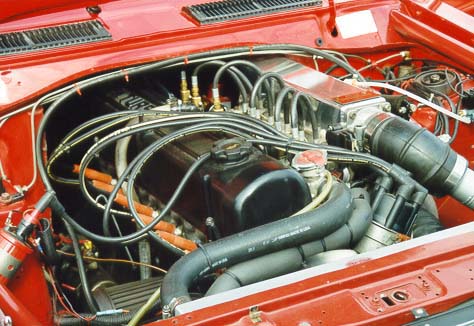
High-power Turbo Fours
The advantage of these engines are that they are fairly lightweight (being four cylinder engines) and in stock form give much more power than the A-series engines. But it does take considerable craftsmanship to fit one in including the intercooler.
How efficient are these engines?
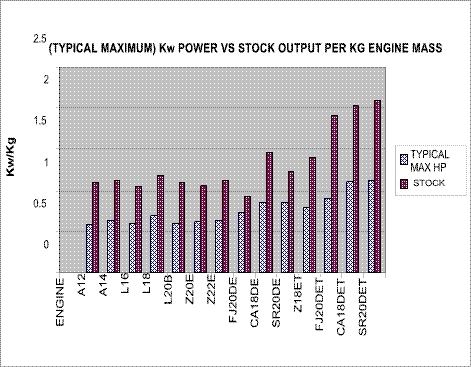
This chart shows that the FJ, CA and SR Turbo engines are twice as efficient than most engines in the matter of power/weight ratio. I estimate a 300 hp CA18DET (282 pounds) would weigh nearly half that of 300 hp GM V8 (500 pounds).
Of course, the easiest way to go fast is: less weight, more power. These turbo fours deliver.
CA18DET
See main article: CA-Series Engine Swaps
There is a lot of information in the main forum on all aspects of the CA18DET swap.
SR20DET
See main article: SR engine swap
The SR20 can bolt-in without cutting the firewall, though it's easier with an originally automatic-equpped car (which has a bigger central tunnel).
FJ20DET
See main article: FJ engine swap
The F20DET engine was basically a detuned race engine, a bit heavy but possibly Nissan's strongest ever engine. The stock engine can take massive boost and survive, while turning out incredible horsepower thanks to its 16-valve head.
V6s and V8s?
Yes, V6s and V8s can be swapped into Datsun 1200s (and have been!), with increasing amounts of crafting and modification required. Your 1200 won't handle curvy roads too well with all that weight up front, but that's not the point of this, eh?
V6
Nissan VG Engine Swap SOHC V6
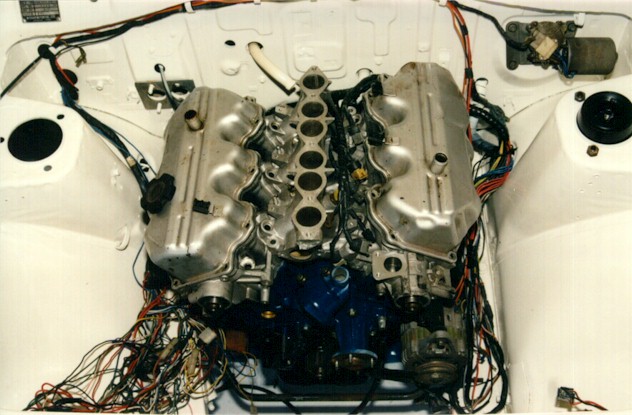
Nissan VQ Engine Swap DOHC V6
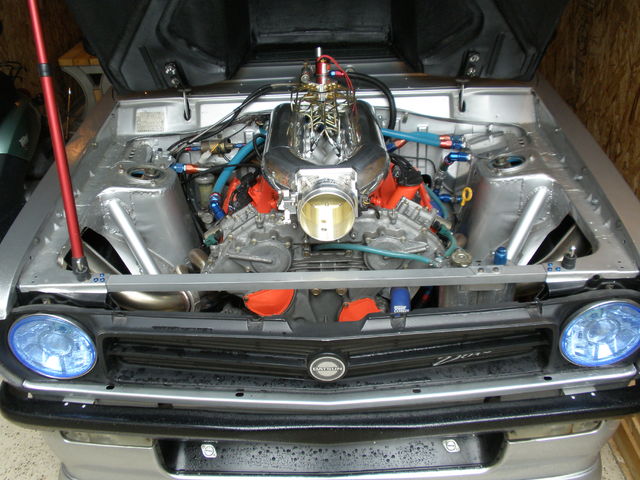
GM 3800 Engine Swap (Buick 3.8 V6)
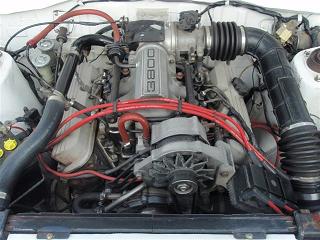
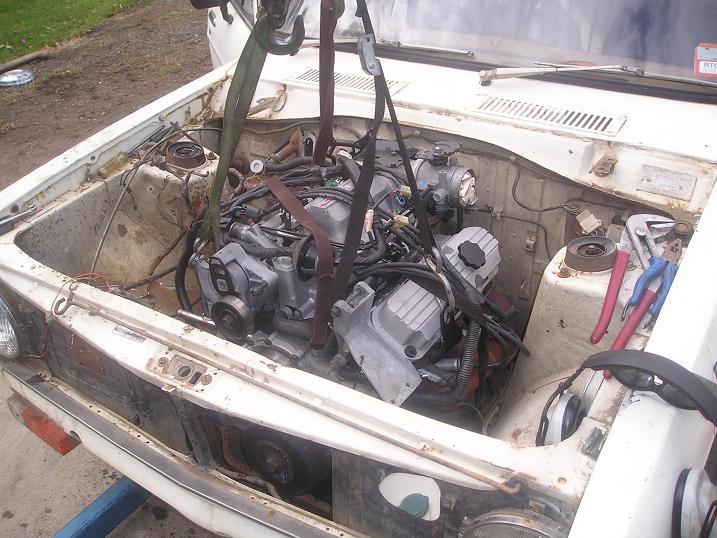
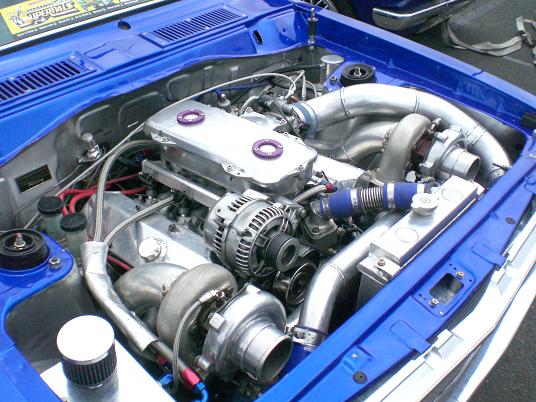
GM 3100 Engine Swap (Chevrolet 60-degree V6)
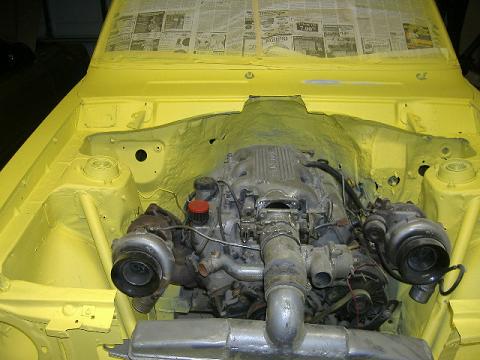

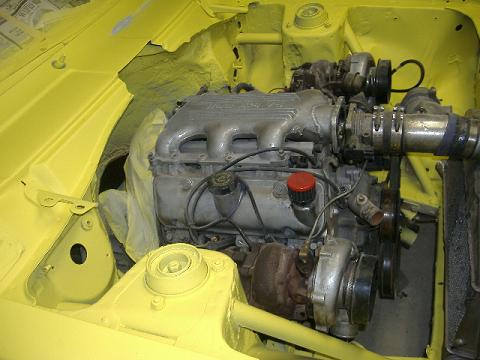

South Africa GX Coupe with V6 stroker, M75 diff, Cressida gearbox, rollcage

Ford Essex V6? (front-distributor engine)
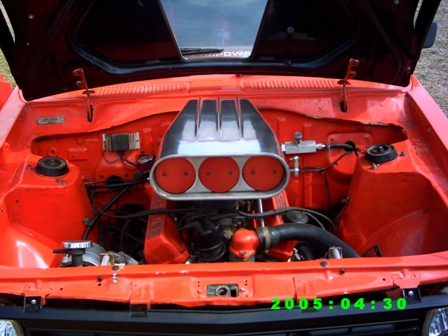
L6s
Straight six (L6/inline six).
- GM Holden Six
DAT186 - GM Holden 186 in Datsun 1000
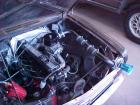

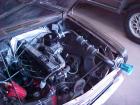
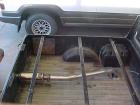

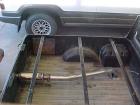
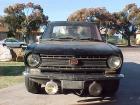
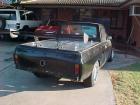
V8s
See main article: V8
RB Engine
Straight-six Skyline motors may be swapped into a 1200 by using engine setback. Even so the engine must come forward as far as possible, with the fan removed from the engine and a pusher fan placed in front of the radiator.
RB20 in B210 - Built by Steve and Kev
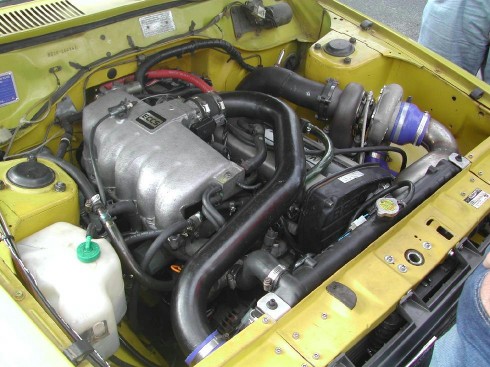
RB engine in Silvia#S15
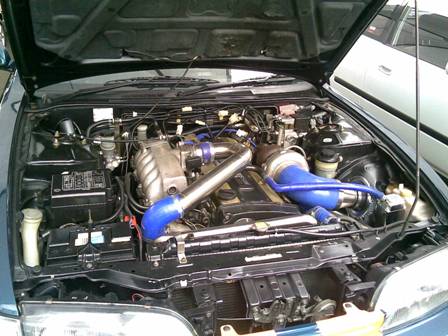
RB engine is bakkie. Plenty of room for radiator & front mounted intercooler
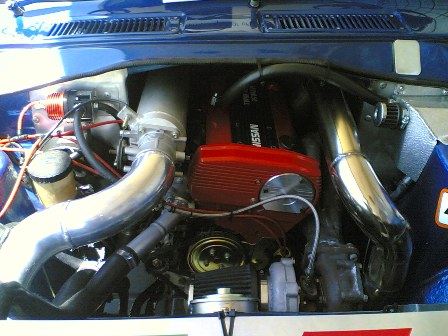
Challenge Engine Swaps
The following are not known to have been successfully completed.
More information on any of these subjects can be found in the Forums.
QR-Series Engine
See QR-Series Engine
- QR25DE 2.5 liter Nissan/Infiniti engine. Pluses: 13% lighter than SR20DE, 20% lighter than KA24DE. 30mm shorter than SR20, so possibly fitting the 1200 very well. It also has twin, counterrotating balance shafts so it should be a nice smooth engine. The drive-by-wire throttle body should make for easy swap (no throttle linkage to worry about).
Mazda B6 DOHC Head Swap
Mazda B6 DOHC head on A-engine. Head bolts on, but water and oil passages are different.
CR-Series Engine
See main article: CR Engine Swap
Nissan CR engine is an all-alloy 16-valve engine -- the modern A-series, with same displacements and general engine dimensions. CR14DE is the most powerful.
GA-Series Engine
See main article GA Engine Swap
The Nissan GA16 engine is similar to the A15, but distributor is in the back and RWD transmissions are avialable and Asia and Europe markets. The compelling part of this swap is 116 HP from variable cam timing. You could even carburete this engine and still use the VCT with an RPM-activated 12V relay.
HR16 Engine
HR16 replaced GA16, yet makes less HP.
HR16DE: 2009+ 112 HP GA16DE: 1992+ 115 HP with wikipedia:N-VCT QG18DE: 1999+ 114 HP (but with 130 lb ft torque vs 110 lb ft of GA16DE) QG18DD: 1999+ 114 HP, 128 ft lb torque 1999-2004 Nissan Sunny
AY12 Engine
Nissan Mystery Motor
Electric Power
See main article: Electric
Tire-smokin' fast no-petrol Datsun 1200s. It's Electric
* Discussion: Electric-engined 1200s.
Non-Nissan Engines
NOTE to newbys: Beware of mentioning rotary-powered or Toyota 4A engine-powered 1200s. Some club members may get offended! But really, these are also excellent engines that fit in fairly well. Just don't tell anybody ;-)
GB Engine
Suzuki G-series B engine is a lightweight, high-output, twin-cam four cylinder. For example, the G13B from GTI Swift is lighter than A15, but 109 HP compare to 80HP for an A15.
See main article: Suzuki GB Engine Swap
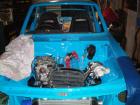
Astron
4G5 Mitsubishi Astron engineᵂ in Datsun 1200 up to 2.6 liter

Sirius
4G6 Mitsubishi Sirius engineᵂ. 4G63 (2 liter) as fitted to Starion.
Toyota Hemi
Toyota Twin-Cam
3S-GTE Celica/MR2 engine (stock 200-245 hp). Use a POST Holden Corona RWD bellhousing
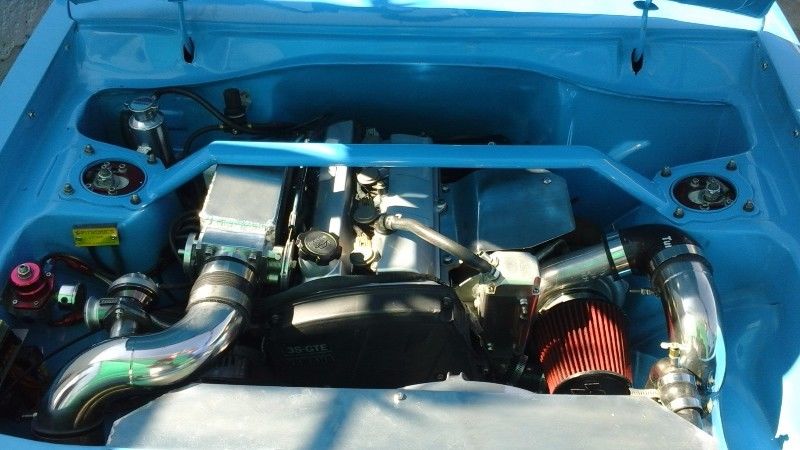
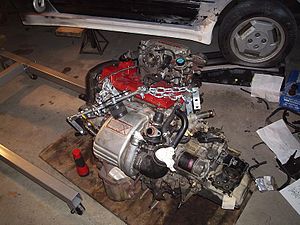
See main article: Toyota 4A engine
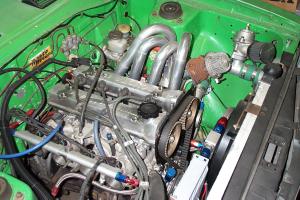
Toyota JZ Six
See main article: JZ
Straight Six 1JZ 2.5 liter 2JZ 3.0 liter
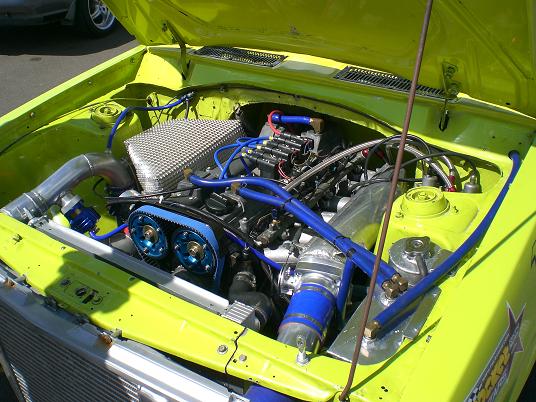
Toyota M Six
mrwilson had this Turbocharged 7M-GTE 1992 Supra six-cylinder engine in his ute. More pics at mrjpwilson
It was for sale in 2010: Nissan 1400 turbo
Fiat Twin-Cam
A Fiat DOHC engine powers one of the fastest Datsun 1200s on the planet.
Mazda Piston Engine
See Mazda piston engine swap
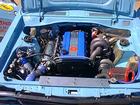 Mazda 2-liter DOHC piston engine
Mazda 2-liter DOHC piston engine
Mazda Wankel Engine
See * Mazda rotary engine swap * 13B engine swap
Volvo
Post: Swedish 2 dr Sedan with a rear mounted Volvo T5 engine 200ps
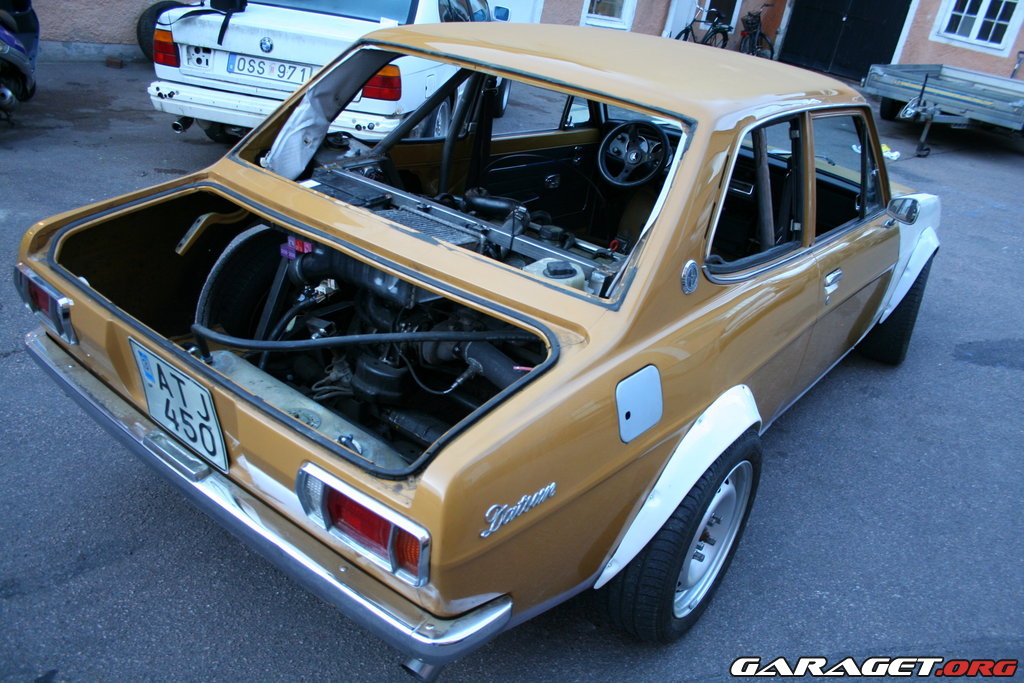
VW
Audi 1.8T
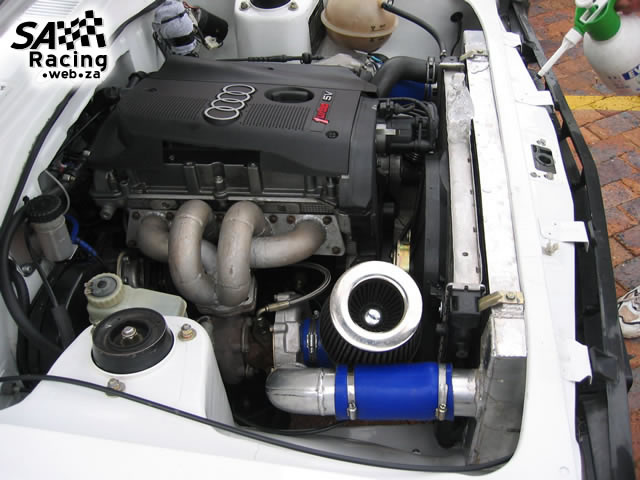 album
album
Audi 1.8
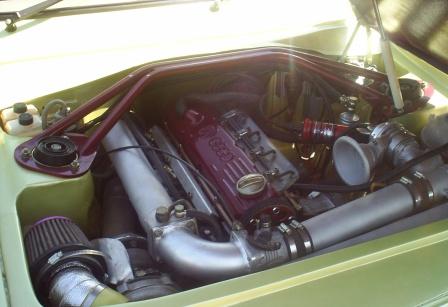 album
album
I'm in Australia. Are there limits to what engine size I can use?
In Australia, engine swaps are regulated by government guidelines. What's the largest size engine you can swap into a 1200? Per NCOP (National Code Of Practice), engine size is limited according to the tare weight of the car. For the 1200, a 2.0 liter naturally aspirated engine, or a 1.8 liter turbo engine is allowed (hence the popularity of the CA18DET swap). An engineer must certify the installation per old-car Design Rules, so check before starting!
1200 sedan: 2.0 liters, or 1.8 turbo, or 1.2 rotary 1200 ute: 2.0 liters, or 1.8 turbo, or 1.2 rotary
If you must have a street-legal V8-powered 1200, it is possible as an ICV (Individually Constructed Vehicle) but very expensive to certify according to new-car Australia Design Rules.
Also See
* B210 Engine Swaps
Other Vehicles
A12, A14 and A15 have been used in boats and as industrial engines.
See: * Boats * Carpet Cleaning Machine * Nissan and TCM Forklift
Engine weights and specs
| A12 | 87 kg | 192 lbs |
| A14 | 93 kg | 205 lbs |
| 2ZZ-FE | 97 kg | 210 lbs |
| L18 | 118 kg | 260 lbs |
| CA18ET | 118 kg | 260 lbs |
| QR25DE | 121 kg | 267 lbs |
| CA18DET | 128 kg | 282 lbs |
| E1 | 138 kg | 304 lbs |
| SR20DE | 139 kg | 306 lbs |
| SR20DET | 149 kg | 328 lbs |
| FJ20ET | 166 kg | 366 lbs |
| Z20 | 157 kg | 346 lbs |
| KA24DE (estimated) | 167 kg | 368 lbs |
| VG30 | 166 kg | 360 lbs |
| VQ35 alloy engine | 142 kg | 313 lbs |
| VG30DETT | 277 kg | 510-610 lbs |
| Ford 2.8 V6-60 | 138 kg | 305 lbs |
| Ford 3.8 V6-90 | 159 kg | 351 lbs |
| Ford 3.0 SHO V6-60 | 211 kg | 465 lbs |
| Ford 3.2 SHO V8-60 | 177+ kg | 390+ lbs |
| Rover 3500 (215 cu. in.) V8 | 144 kg | 318 lbs |
| GM BOP Alloy 3.5l (215 ci) V8 | 145 kg | 318 lbs |
| Ford 5.0 | 204 kg | 450 lbs |
| Chevrolet Small Block V8 | 250 kg | 550 lbs |
| Chevy Gen-III Alloy 6.0-litre (LS2) | 220 kg | 485 lbs |
| Chevy Gen-III Alloy 7-litre (LS7) | 208 kg | 458 lbs |
| Hemi 392 | 337 kg | 745 lbs |
Spec references:
- Datsuns.com/Tech
- Datsun A ja L moottorien tekn. tiedot
- http://www.sportcompactcarweb.com/tech/0104scc_atunersguide
- Read discussion about how engine weight specs are varying (for example: Nissan RB engine weighs more than GM smallblock V8?): Hybrid Z's Complete Engine Weights Table
- [[1] Dave William's Engine Weight/Size] or http://www.bacomatic.org/%7Edw/txt/engfyi.htm or http://www.angelfire.com/ar/dw42/engfyi.htm
NOTE: Engine weights are measured different ways (with oil, without, etc), so take this with a grain of salt. Even more useful comparo would be the engine/trans combo weight. From this chart it may seem that a certain engine will only weigh a few kilos more, but add the weight of the matching transmission and it may be quite a lot more than the other engine/trans combo.
The total weight will be way up because of heavier transmission, diff, brakes, etc.
1200 after Z24 swap (2150 pounds) + 190lb driver = 2350 lbs (1068 kg)
 post
post

![[Datsun 1200 encyclopedia]](/wiki/upload/wiki.png)
